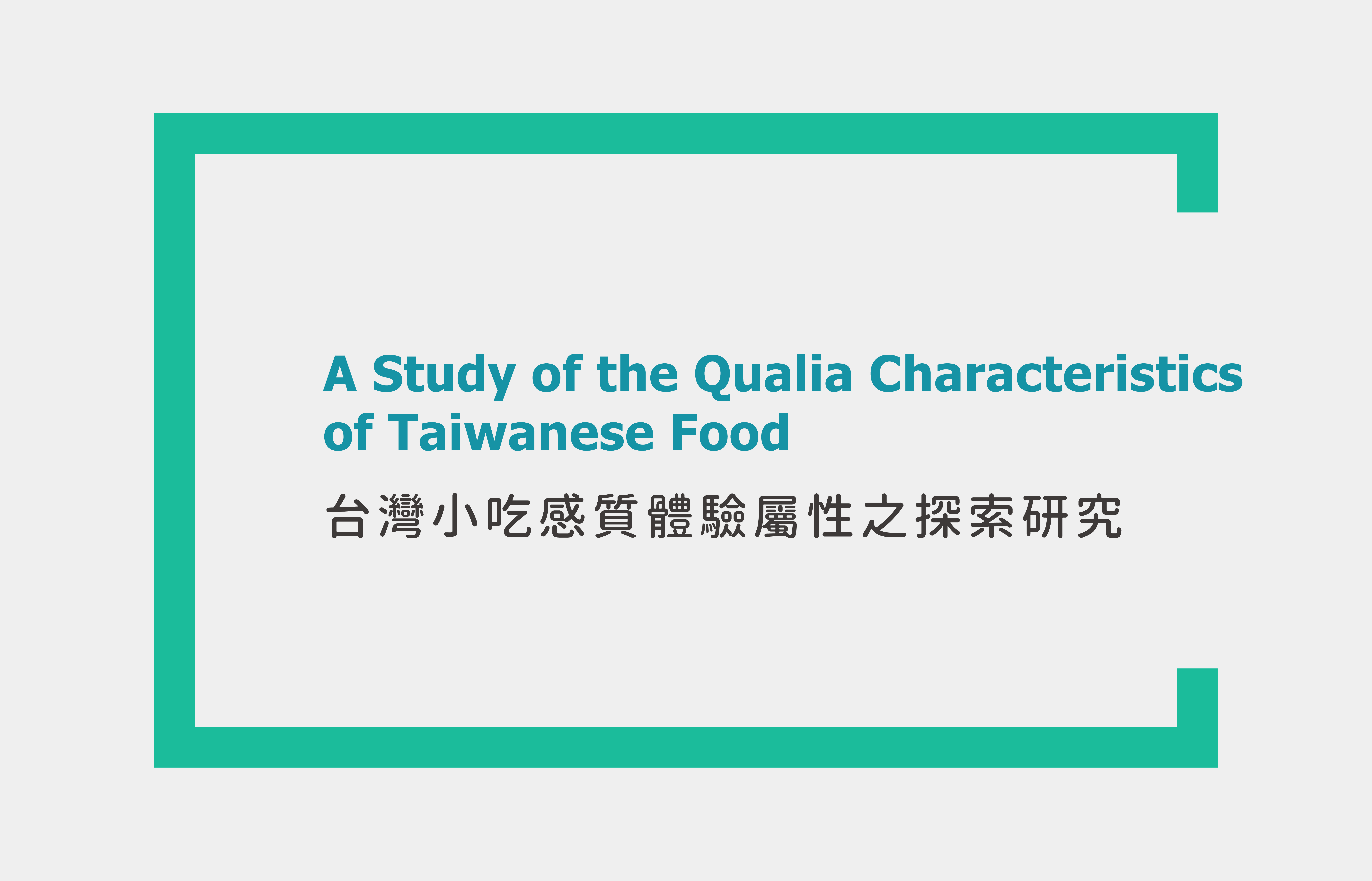台灣小吃感質體驗屬性之探索研究
A Study of the Qualia Characteristics of Taiwanese Food
中文摘要
美食體驗是國際旅客瞭解在地文化的重要途徑,相關研究發現感質體驗是產品設計的重要議題,感質體驗感受攸關消費者對於美食體驗的滿意度。而大多數研究僅提到感質的影響因素,缺乏對於飲食的感質體驗的量化研究。臺灣地處亞洲要衝且歷史融合多元文化,塑造臺灣飲食文化獨特且多元的特色,台灣美食也成為國際間體驗台灣文化關鍵媒介。因此,美食如何融入感質體驗,成為國際美食行銷之重要課題。本研究遴選出八種臺灣代表小吃以及十二種感質因素,以量化問卷方式,有效問卷222份,經由差異分析、相關分析、集群分析、多尺度分析瞭解消費者對於小吃感質體驗的感受與分類方式。研究發現:(1)飲食體驗者可以區分成實惠取向、在地取向、美食取向與流行取向;(2)年齡與性別在小吃喜好度與代表度具有顯著差異;(3)小吃喜好度與風味多樣、口感豐富、專業廚藝、營養健康、方便攜帶、本土在地、精雕細琢具有顯著正相關;(4)小吃代表性與層次豐富、本土在地具有顯著正相關。
Abstract
Food experience is crucial for international tourists to understand local cultures. Studies have revealed that qualia are critical for product design. Qualia are closely related to consumer satisfaction with food experience. However, most studies have only mentioned factors that influence qualia, and no quantitative studies on food qualia have been conducted. Taiwan is an Asian hub with a history incorporating diverse cultures, thus creating a unique and diverse food culture. Taiwanese food has become a key medium for foreigners to experience Taiwanese culture. Therefore, integrating food into qualia is an essential topic for international food marketing. In this study, we selected eight typical Taiwanese foods and 12 qualia to conduct a quantitative questionnaire survey. Overall, 225 valid responses were collected. By conducting variance, correlation, cluster, and multidimensional analyses, consumers’ perception and classification of the qualia of Taiwanese foods were explored. The results were as follows. (1) People with food experience can be oriented toward affordability, locality, gourmet, and popularity. (2) Food preferences were significantly correlated with diverse flavors, rich taste, professional cooking, healthy nutrition, convenience, locality, and delicateness. (3) Food representativeness was significantly correlated with rich taste and locality.
參考文獻
1. Björk, P., Kauppinen-Räisänen, H.: Exploring the multi-dimensionality of travellers' culinary-gastronomic experiences. Current Issues in Tourism. 19(12), 1260-1280 (2016).
2. CNN: 40 of the best Taiwanese foods and drinks. http://edition.cnn.com/travel/article/40-taiwan-food/index.html. Accessed 25 Jan 2020
3. CNN: You voted: World's best food is in .... http://edition.cnn.com/travel/article/world-best-food-culinary-journeys/index.html. Accessed 25 Jan 2020
4. Ellis, A., Park, E., Kim, S., Yeoman, I.: What is food tourism? Tourism Management. 68, 250-263 (2018). https://doi.org/10.1016/j.tourman.2018.03.025
5. Florek, M., Conejo, F.: Export flagships in branding small developing countries: The cases of Costa Rica and Moldova. Place Branding and Public Diplomacy. 3(1), 53-72 (2007).
6. Forristal, L. J., Lehto, X. Y.: Place branding with native species: Personality as a criterion. Place Branding and Public Diplomacy. 5(3), 213-225 (2009).
7. Gordin, V., Trabskaya, J.: The role of gastronomic brands in tourist destination promotion: The case of St. Petersburg. Place Branding and Public Diplomacy. 9(3), 189-201 (2013). https://doi.org/10.1057/pb.2013.23
8. HO Sa-Na.: The Globalization of Korean Food: Korean Cuisine and the Construction and Imagination of a Korean National Brand. Journal of Chinese Dietary Culture. 13(1), 165-203 (2017)
9. Lee, K.-H., Scott, N.: Food tourism reviewed using the paradigm funnel approach. Journal of Culinary Science & Technology. 13(2), 95-115 (2015). https://doi.org/10.1080/15428052.2014.952480
10. Lin, L., Mao, P. C.: Food for memories and culture–A content analysis study of food specialties and souvenirs. Journal of Hospitality and Tourism Management. 22, 19-29 (2015). https://doi.org/10.1016/j.jhtm.2014.12.001
11. Lin, L.: Food souvenirs as gifts: tourist perspectives and their motivational basis in Chinese culture. Journal of Tourism and Cultural Change. 15(5), 439-454 (2017). https://doi.org/10.1080/14766825.2016.1170841
12. Lin, Y. C., Pearson, T. E., Cai, L. A.: Food as a form of destination identity: A tourism destination brand perspective. Tourism and Hospitality Research. 11(1), 30-48 (2011). https://doi.org/10.1057/thr.2010.22
13. Mak, A. H., Lumbers, M., Eves, A., Chang, R. C.: Factors influencing tourist food consumption. International Journal of Hospitality Management. 31(3), 928-936 (2012).
14. Ministry of Economic Affairs: Gourmet TAIWAN. https://ws.ndc.gov.tw/Download.ashx?u=LzAwMS9hZG1pbmlzdHJhdG9yLzEwL1JlbEZpbGUvNTU2Ni81MjMzLzAwMTM5OTEucGRm&n=OTkwNTI25Y%2bw54Gj576O6aOf5ZyL6Zqb5YyW6KGM5YuV6KiI55WrKOS%2fruato%2baguOWumuacrCkucGRm&icon=..pdf. Accessed 25 Jan 2020
15. Ron, A.S., Timothy, D.J.: “The land of milk and honey: biblical foods, heritage and Holy Land tourism”, Journal of Heritage Tourism. 8(2-3), 234-247 (2013). https://doi.org/10.1080/1743873X.2013.767817
16. Sanchez-Cañizares, S., Castillo-Canalejo, A.: "A comparative study of tourist attitudes towards culinary tourism in Spain and Slovenia", British Food Journal. 117(9), 2387-2411 (2015). https://doi.org/10.1108/BFJ-01-2015-0008
17. Sims, R.: Food, place and authenticity: local food and the sustainable tourism experience. Journal of sustainable tourism. 17(3), 321-336 (2009). https://doi.org/10.1080/09669580802359293
18. Taipei City Government.: Must Eat in Taiwan. https://www.travel.taipei/zh-tw/must-visit/snacks-top10. Accessed 25 Jan 2020
19. Yen, H. Y., Lin, P. H., Lin, R.: Qualia characteristics of cultural and creative products. Journal of Kansei, 2(1), 34-61 (2014).
20. Yen, H. Y., Lin, R., Lin, R.: A study of value-added from qualia to business model of cultural and creative industries. Journal of National Taiwan University of Arts, 91. 127-152 (2012). DOI: 10.6793/JNTCA.201210.0127
21. Yung-Hui Chou, Hsin-Yi Ou-Yang, Kuan-Chu Chen: Taiwan Tourism 2020: A Sustainable Tourism Development Strategy. Taiwan Modern Tourism. 1(1), 1-20 (2018). 10.6348/TMT.201809_1(1).0001
22. Yurtseven, H. R., Kaya, O. Local Food in Local Menus: The Case of Gokceada. Tourismos, 6(2), 263-275 (2011).
